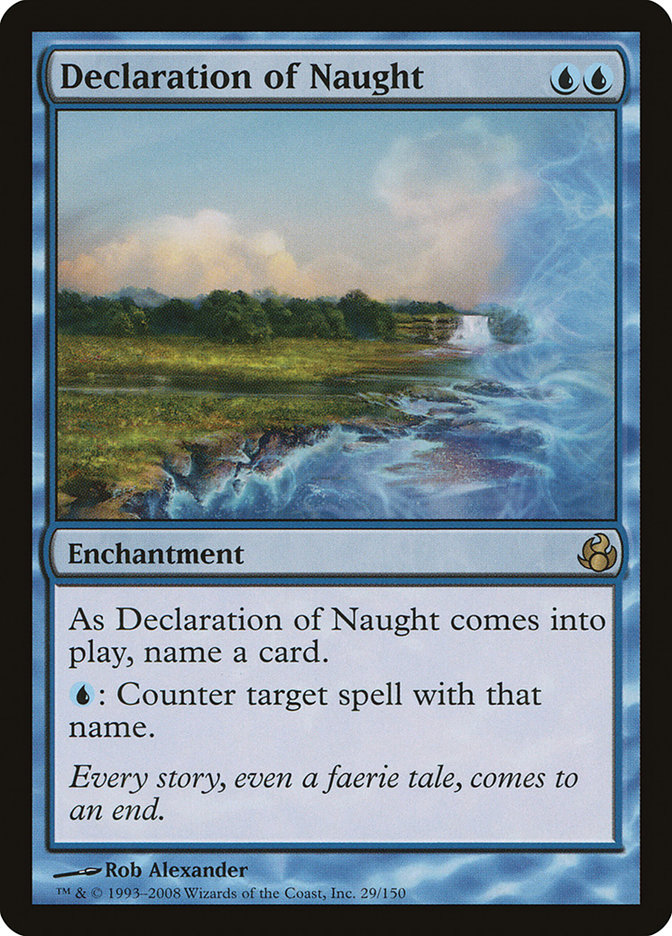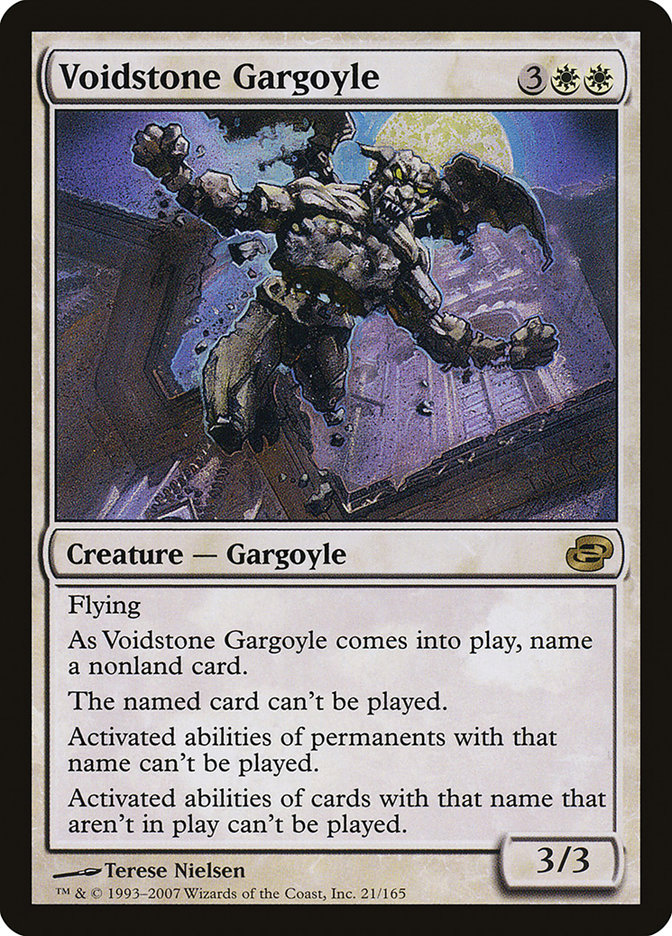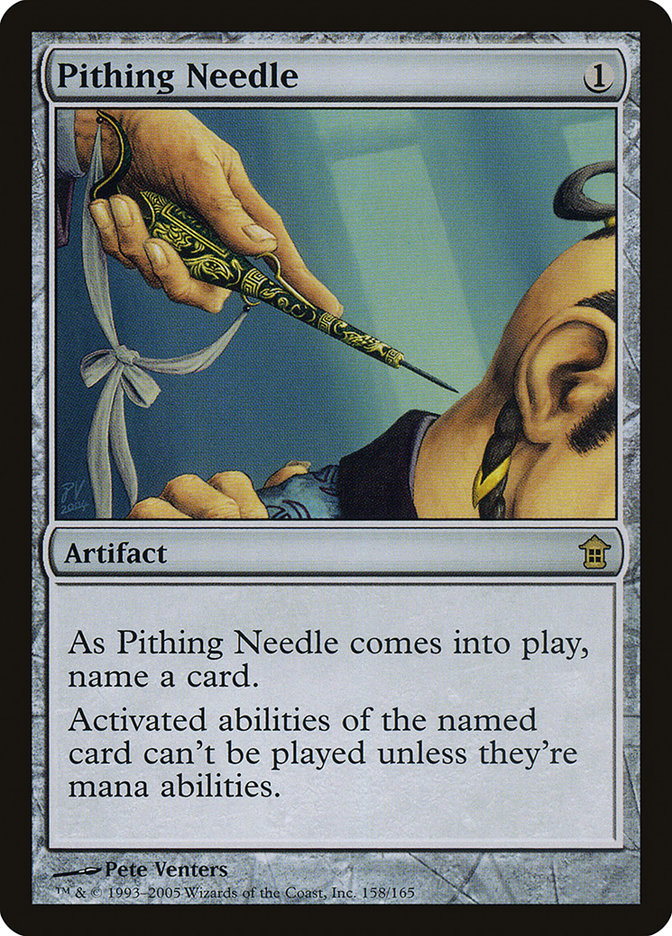Declaration of Naught MTG Card
| Mana cost | |
| Converted mana cost | 2 |
| Rarity | Rare |
| Type | Enchantment |
| Released | 2008-02-01 |
| Set symbol | |
| Set name | Morningtide |
| Set code | MOR |
| Number | 29 |
| Frame | 2003 |
| Layout | Normal |
| Border | Black |
| Illustred by | Rob Alexander |
Key Takeaways
- Declaration of Naught disrupts opponents by countering specific spells and conserving your resources.
- Instant speed allows flexibility in play, but a steep color-specific mana cost can limit deck integration.
- It’s invaluable when facing popular spells in the meta but may not be efficient against varied strategies.
Text of card
As Declaration of Naught comes into play, name a card. : Counter target spell with that name.
Every story, even a faerie tale, comes to an end.
Card Pros
Card Advantage: The Declaration of Naught can provide an edge by preemptively countering key spells your opponent relies on, effectively reducing their available resources and disrupting their strategy while protecting your own game plan.
Resource Acceleration: While Declaration of Naught itself isn’t a resource accelerator, it aids in preserving your resources by saving them for other spells instead of using them to react to threats that you can prevent from ever taking effect.
Instant Speed: Declaration of Naught can be played at instant speed, giving you the flexibility to respond to your opponent’s actions during their turn or at the end of their turn, keeping them guessing about your capabilities and remaining agile in your strategy.
Card Cons
Discard Requirement: When it comes to Declaration of Naught, the need to identify a spell name upon activation can be seen as a discard of sorts. You must call your shot and choose wisely, or risk the enchantment becoming a dead card against an unexpected opponent’s strategy.
Specific Mana Cost: This enchantment requires two blue mana. For players running multicolored decks, the double blue cost constrains mana flexibility, potentially complicating its usage in anything but mono-blue or heavily blue-oriented decks.
Comparatively High Mana Cost: While two mana points don’t seem excessive, the fact remains that Declaration of Naught is an investment in a potential future payoff. It depends on the opponent playing the named card, which might not occur in every matchup, leading to mana that could have been allocated for immediate threats or opportunities.
Reasons to Include in Your Collection
Versatility: Declaration of Naught offers a unique form of control that can be adapted to any situation. With its ability to name a card and counter any spell with that name, it can hinder opponents’ key strategies or protect your interests across various matchups.
Combo Potential: This card opens up space for creative combos in decks that capitalize on permission and control tactics. It can work in tandem with cards that peek at opponents’ hands or with those that benefit from spells being countered, thus increasing overall synergy.
Meta-Relevance: In a game environment that’s dominated by certain powerhouse spells, Declaration of Naught can be a silver bullet. It’s particularly effective when you’re aware of the common threats prevalent in the current metagame, allowing you to preemptively shut down opponents’ plans.
How to beat
Confronting a Declaration of Naught on the battlefield requires strategic foresight and an understanding of how to dismantle its control. This blue enchantment allows a player to counter any spell with a chosen name for as long as it remains on the field. Key to victory against Declaration of Naught is diversifying one’s threats, which can dilute its power to neutralize a single spell. The use of spells that cannot be countered, such as Abrupt Decay or Supreme Verdict, offers a dependable path to bypassing its restrictive force.
Artifact removal is another tactic to clear the way, with options like Disenchant and Naturalize, giving players a chance to destroy this troublesome enchantment directly. Hand disruption mechanics, especially those that extract specific cards before they are played, like Thoughtseize or Inquisition of Kozilek, can prevent an opponent from setting up Declaration of Naught’s defensive barrier in the first place.
Consistent pressure and adaptability define the approach needed to triumph over Declaration of Naught. Introducing multiple avenues for victory can overwhelm the enchantment’s singular focus, carving a path to overcome this control piece in your MTG matchups.
Cards like Declaration of Naught
Declaration of Naught is a unique counter spell in the realm of Magic: The Gathering, reminiscent of cards that allow players to target specific threats. Its similarity to Meddling Mage is evident as both can preemptively shut down key cards from an opponent’s strategy. However, Declaration of Naught’s focus on countering spells as they are cast, using a repeatable ability, sets it apart from Meddling Mage’s static nature.
Another analog is Voidstone Gargoyle, which also name cards to neutralize. Yet, it differs in form as a creature and in function, preemptively nullifying abilities rather than waiting for the spells to be cast. This is where Declaration of Naught shines, providing ongoing control and tactical flexibility. Pithing Needle also mirrors the ability to name cards, yet only deactivates activated abilities, not spell casts themselves.
Ultimately, Declaration of Naught offers a dynamic control tool for players. It proves to be a formidable card, particularly in formats where predicting and countering key spells can be game-changing. Each alternative brings its own strategy and utility, yet the nuance of Declaration of Naught’s countering capability might be unmatched for those seeking to command the flow of battle.
Where to buy
If you're looking to purchase Declaration of Naught MTG card by a specific set like Morningtide, there are several reliable options to consider. One of the primary sources is your local game store, where you can often find booster packs, individual cards, and preconstructed decks from current and some past sets. They often offer the added benefit of a community where you can trade with other players.
For a broader inventory, particularly of older sets, online marketplaces like TCGPlayer, Card Kingdom and Card Market offer extensive selections and allow you to search for cards from specific sets. Larger e-commerce platforms like eBay and Amazon also have listings from various sellers, which can be a good place to look for sealed product and rare finds.
Additionally, Magic’s official site often has a store locator and retailer lists for finding Wizards of the Coast licensed products. Remember to check for authenticity and the condition of the cards when purchasing, especially from individual sellers on larger marketplaces.
Below is a list of some store websites where you can buy the Declaration of Naught and other MTG cards:
- eBay
- TCG Player
- Card Kingdom
- Card Market
- Star City Games
- CoolStuffInc
- MTG Mint Card
- Hareruya
- Troll and Toad
- ABU Games
- Card Hoarder Magic Online
- MTGO Traders Magic Online
See MTG Products
Legalities
Magic the Gathering formats where Declaration of Naught has restrictions
| Format | Legality |
|---|---|
| Commander | Legal |
| Legacy | Legal |
| Modern | Legal |
| Oathbreaker | Legal |
| Vintage | Legal |
| Duel | Legal |
| Predh | Legal |
| Penny | Legal |
Rules and information
The reference guide for Magic: The Gathering Declaration of Naught card rulings provides official rulings, any errata issued, as well as a record of all the functional modifications that have occurred.
| Date | Text |
|---|---|
| 2008-04-01 | You can name either half of a split card, but not both. If a player casts the half with the chosen name, it can be targeted by the second ability. In addition, if a player casts a fused split spell with the chosen name, it can be targeted by the second ability. |












